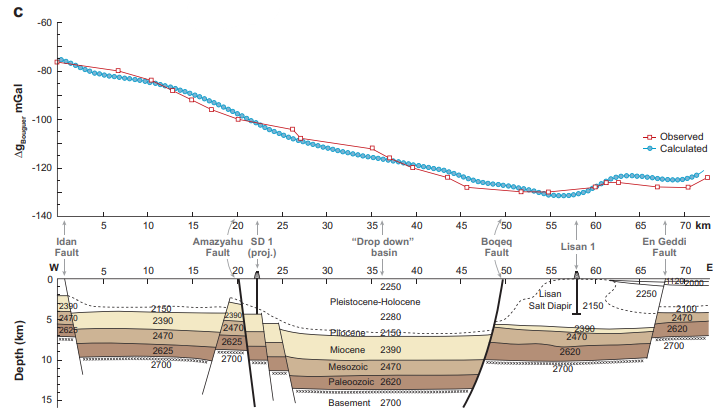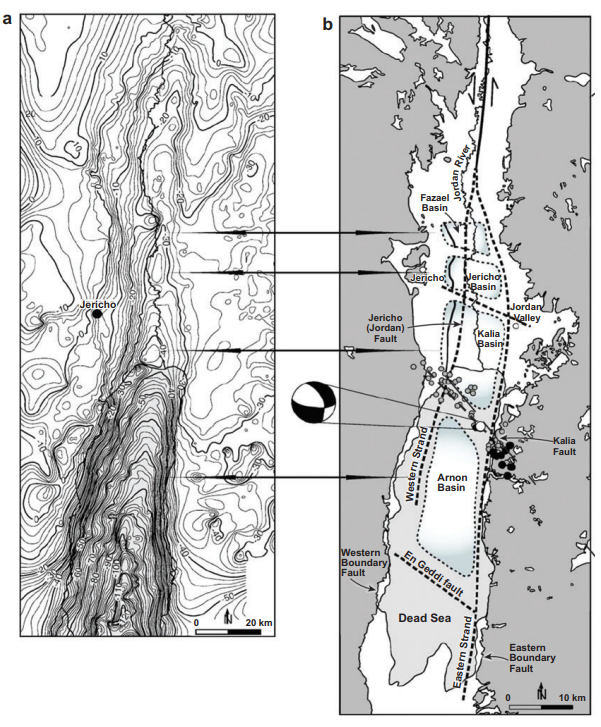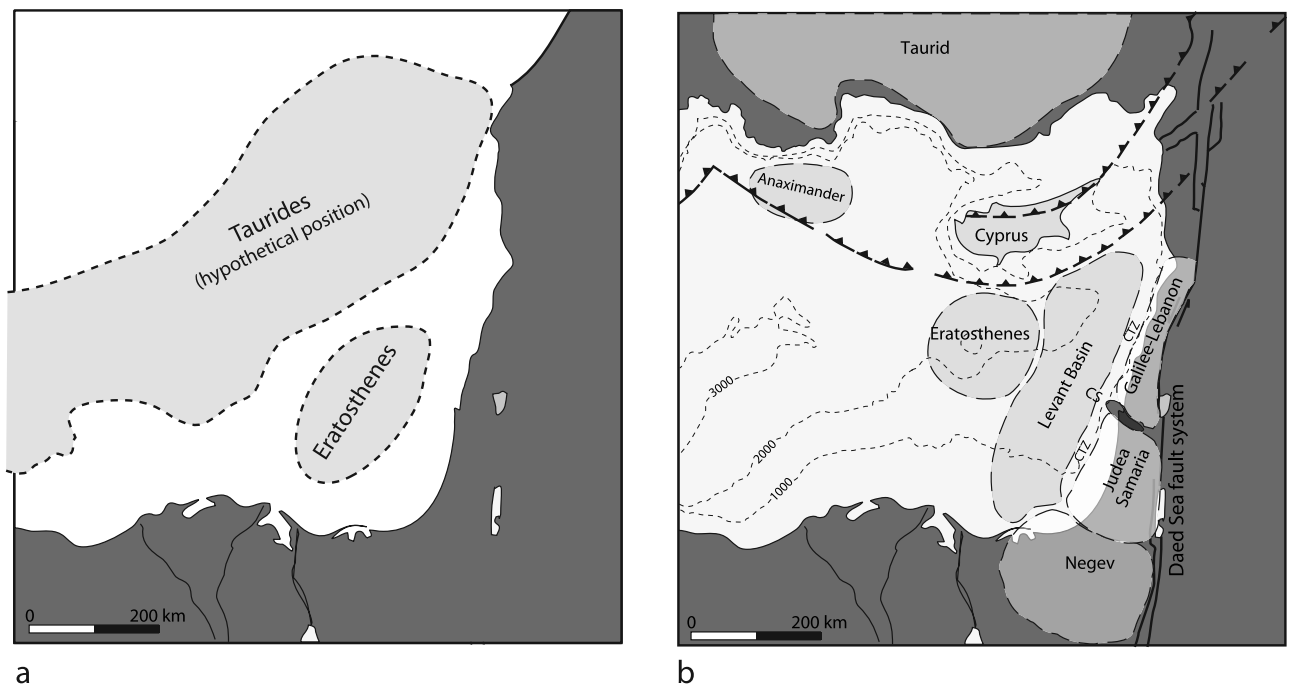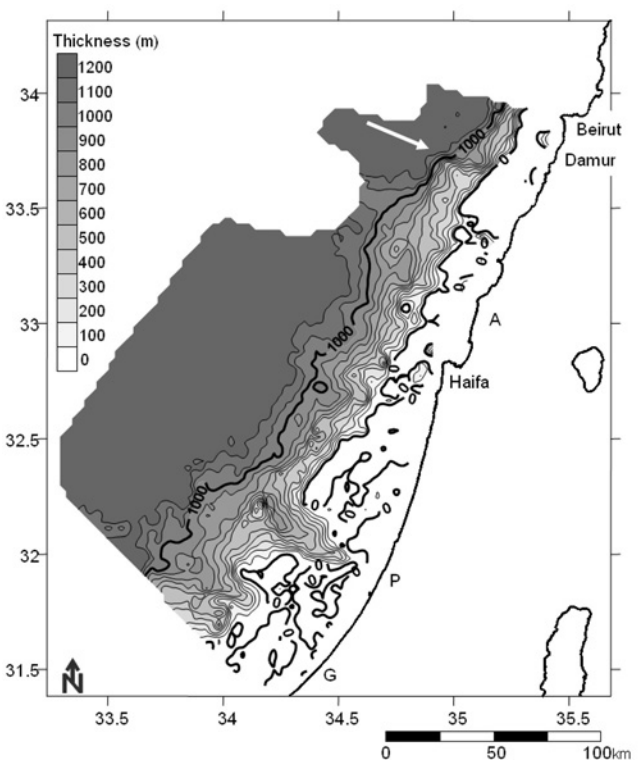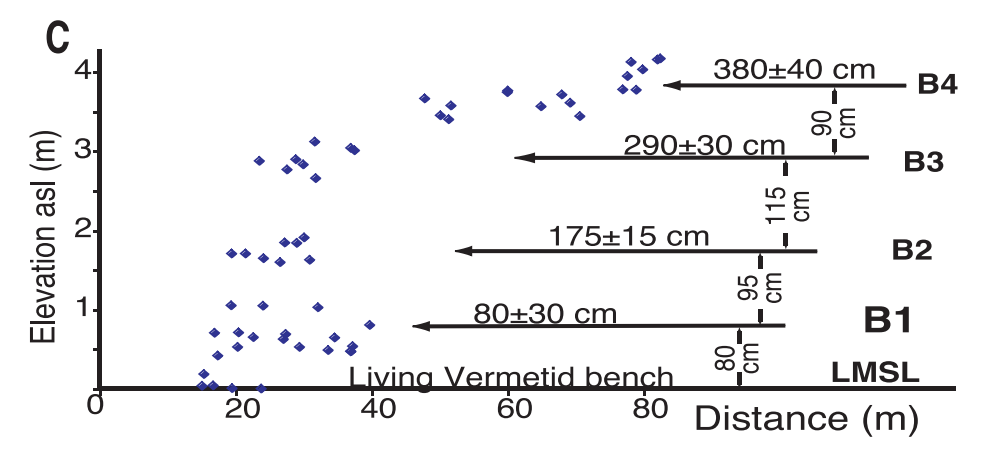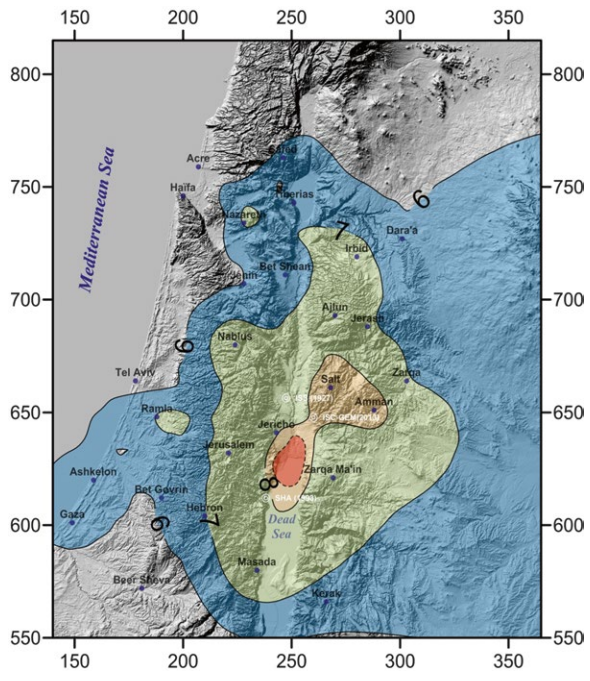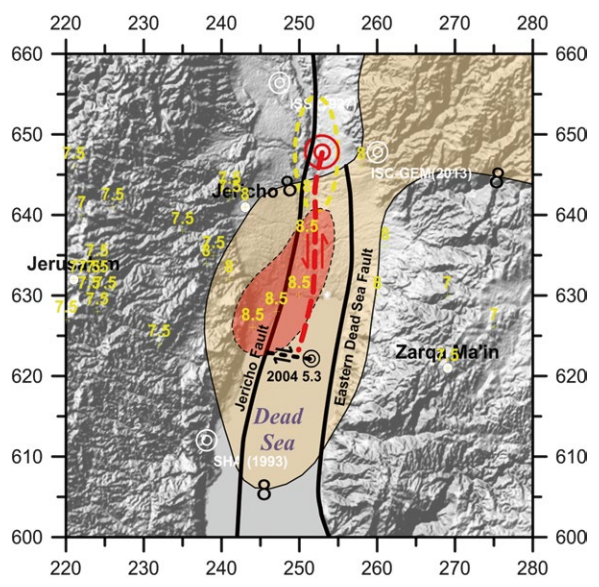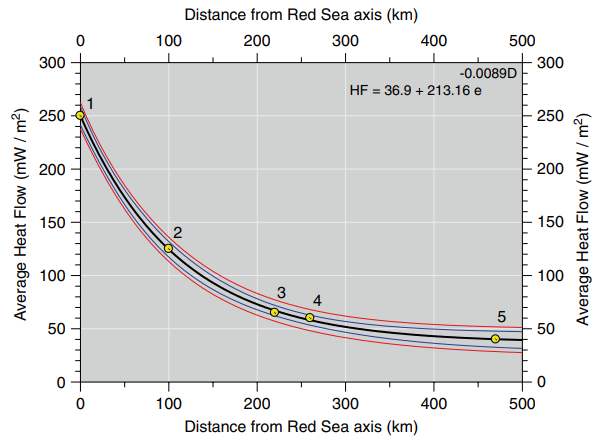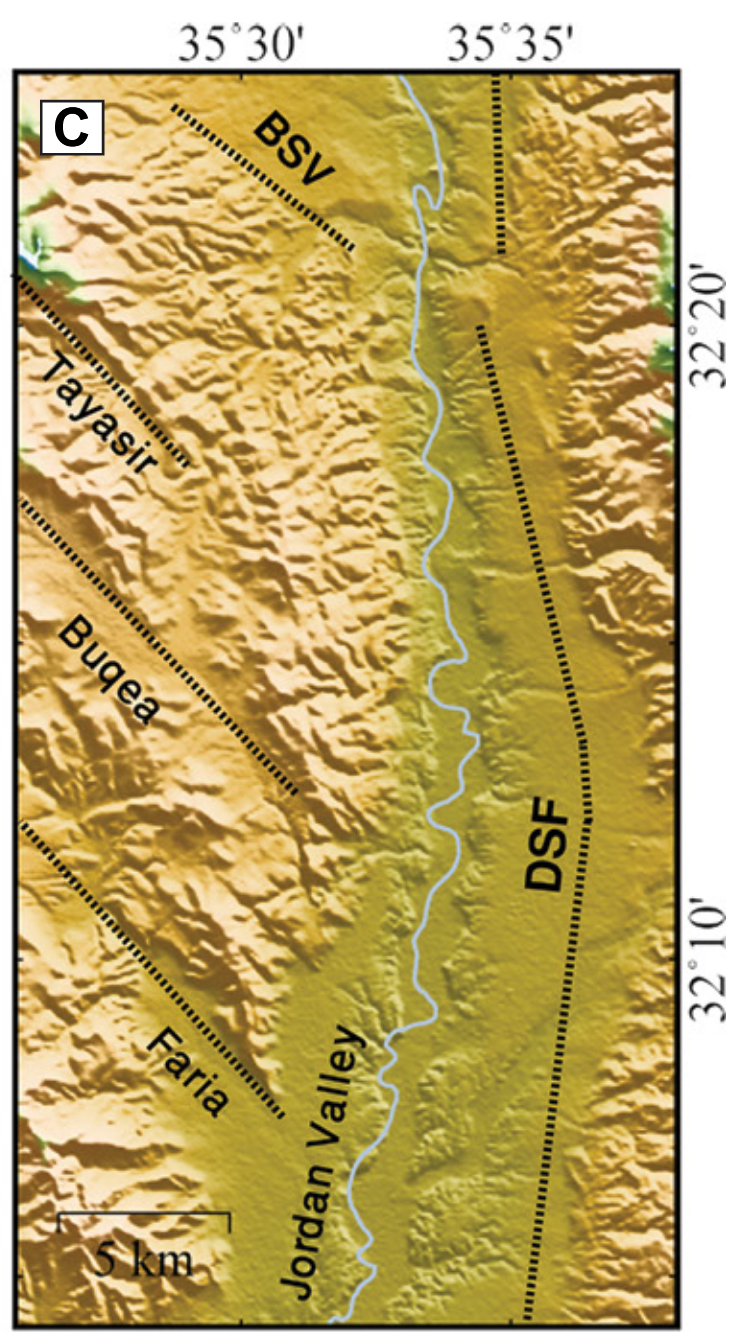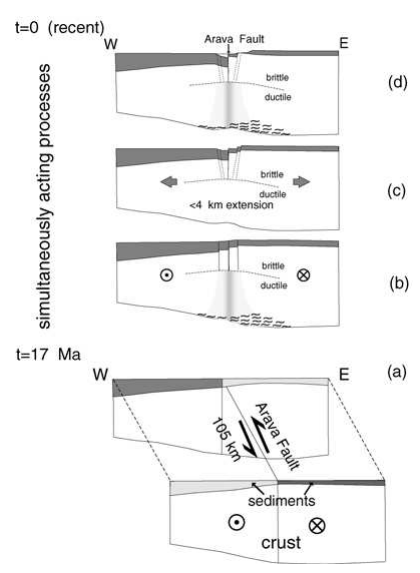Introduction
| Source | Image | Description |
|---|---|---|
| Ben-Avraham et al (2012) |

 Fig. 17.1
Fig. 17.1Tectonic setting of the Dead Sea fault — a transform plate boundary that connects the opening of the Red Sea with the collision in Turkey. Boxes indicate basins along the fault valley discussed in the text.
Ben-Avraham et al (2012) |
Fig. 17.1 - DST Tectonics |
In terms of plate tectonics, the Dead Sea fault is considered to be a left-lateral transform plate boundary with an extensional component, separating the Arabian Plate and the Sinai sub-plate. Activity along the fault is thought to have started in the middle Miocene, when a transition of motion took place from opening in the Gulf of Suez to transcurrent displacement along the Dead Sea fault. The total amount of left lateral slip is estimated at about 105 km. History of motion is not well constrained because young markers cannot be reliably matched across the Fault.
Calculation of regional plate kinematics provides an instantaneous rate of motion along the Fault boundary of about 5-6 mm/yr for the South Sinai triple Junction. This average rate is similar to the average slip computed from the ratio between the entire 105 km slip to ca. 17-20 Ma of tectonic activity (presuming that the overall slip rate has remained approximately uniform during the history of the Fault). More recent GPS measurements provide a minimum slip rate of 3.7 ± 1.1 mm/yr for the three years between 1996 and 1999.
The fault is divided into two sections — the southern section from the Gulf of Elat to south of Lebanon, and a section continuing northward from Lebanon to the Taurus mountain range in Turkey (Garfunkel, 1981). The fault valley is character¬ized by large-scale topographic and structural asymmetries (Wdowinski and Zilberman, 1996). Along the southern section, particularly in the northern Arava valley, the fault's eastern shoulder is flexed upwards towards the axis, resembling an uplifted shoulder, while the western side is flexed down towards the axis, resembling a wide arch. In addition, the eastern side is for the most part topographically higher than the western side. The two sections of the Dead Sea fault differ by a reversal in the large-scale asymmetry; in the southern section (Gulf of Elat to south of Lebanon), the eastern side is usually higher than the western side, while in the northern section (north of Lebanon), the western side is mostly higher than the eastern one.
Along strike variations in topography and structure subdivide the southern Dead Sea fault into five segments. From south to north, these are the Gulf of Elat, Arava, Dead Sea and the Sea of Galilee and the Hula Valley (Fig. 17.1) (Garfunkel, 1981). Deep pull-apart basins, formed between left-stepping fault segments of the Dead Sea fault, can be found in topographically lower areas. Lengths of the individual pull apart basins range from 15 to 50 km and are 5-20 km wide, while their depths range between 5 and 15 km. Marginal normal faults usually border these depressions, while transverse or oblique normal faults define their southern and northern limits. Structural saddles typically occur between the basins and there, transpression often takes place. The crystalline basement underlying the larger pull-aparts is thinner than normal, which accounts for basin subsidence. The basins tend to become shorter and younger in age north¬wards along the fault. Asymmetry occurs in most of the basins, interpreted by Ben-Avraham and Zobak (1992) as indicating that they are bounded by transform segments on one side and sub-parallel normal faults on the other. In these cases, the simple pull-apart model cannot be applied in a straightforward way. Compressional features can be found along many sub-basins, suggesting that the tectonic regime is more complex than specified in the simple models. Both asymmetry and compressional features will be examined in the basins along the southern Dead Sea fault, from the south to the north.
The extensional regime combined with the dominant lateral motion along the Dead Sea fault resulted in the formation of a series of pull-apart basins (or rhomb-shaped grabens). Basins are separated by structural saddles, which formed as a result of local stress fields. In many places, transverse faults cross the saddle, thus separating the basins tectonically as well as structurally.
| Source | Image | Description |
|---|---|---|
| Ben-Avraham et al (2012) |


Profiles and location map from the Gulf of Elat.
Ben-Avraham et al (2012) |
Fig. 17.2 - Gulf of Elat |
At the southern extremity of the Gulf of Elat, local transpression is evident by the uplift of the Tiran Island block on which Quaternary reefs are found at elevations exceeding 500 m above sea level. An additional feature observed in Figs. 17.2A and 17.2B is the existence of asymmetry within the sub-basins of the Gulf of Elat. The transition from the Arnona Deep (Fig. 17.2A) to the Elat Deep (Fig. 17.2B) is accompanied by a change in lateral asymmetry. A possible explanation may be that the basins are bounded on one side by a strike-slip master fault and on the other by a predominantly normal boundary fault. Where motion along en-echelon segments of the main fault switches from one segment to another (i.e., from one side of a basin to the other), asymmetry in the basin structure is also expected to switch sides. According to this interpretation, asymmetry within the basins suggests that in the southern and central portion of the gulf, active strike-slip motion is taking place primarily on the western boundary faults, while in the northern portion it is taking place primarily on the eastern boundary fault (Ben-Avraham, 1985). In addition, it can be seen from Fig. 17.2A that the Arnona Deep is bounded on the east by a large compressional feature.
| Source | Image | Description |
|---|---|---|
| Ben-Avraham et al (2012) |


Profiles from the Zofar basin in the Arava valley.
Ben-Avraham et al (2012) |
Fig. 17.3 - Arava |
This segment of the Dead Sea fault is characterized by a series of elongated, en-echelon tectonic sub-basins. The left stepping arrangement of the basins (Evrona, Ya'alon, Zofar and Shizaf; Frieslander, 2000; Fig. 17.3) coincides with the junction of E-W dextral faults in the central Sinai-Negev area, which predate the left lateral motion on the Dead Sea fault. The depths of these sub-basins, which are filled with clastic sediments, vary from several hundred meters to a few kilometres. The basins are bounded by sub-parallel, longitudinal boundary faults. In general, the boundary faults are high-angle strike-slip faults with normal displacement. In places, due to the left lateral strike slip motion, reverse faults, collapse antithetic features and compressional 'flower structures' were formed (Fig. 17.3). The pattern of these basins subdivides the Arava valley into two low structural segments, separated by an elevated saddle (Frieslander, 2000).
North of this saddle, the Zofar and Shezaf basins are separated by two listric faults with large displacements. The nature of features of the fault on the east side of this segment of the Arava indicate that it is the main strike slip fault (Garfunkel et al., 1981). The asymmetric fill in these sub-basins may well be related to the fact that strike-slip faulting took place mainly along the eastern boundary fault. In the shallowest (Zofar) basin, the seismic data indicate a regional dip toward the north (Frieslander, 2000).
As in the Gulf of Elat, reversal in asymmetry is also observed in the Zofar sub-basin. Figure 17.3B shows a classic example of a strike-slip fault, where horizons on both sides of the fault, dip towards it. Figure 17.3C, located around 15 km to the north, shows a distinctly different picture. Instead of reflectors of the Zofar basin dipping westward towards the fault, they dip to the east and away from the fault. This reversal in dip direction is the only known example along the Arava valley where reversal in asymmetry occurs within a sub-basin (instead of between sub-basins), and may indicate that the Zofar basin can be structurally sub-divided.
| Source | Image | Description |
|---|---|---|
| Ben-Avraham et al (2012) |


Profiles from the Dead Sea basin.
Ben-Avraham et al (2012) |
Fig. 17.4 - Dead Sea Basin |
| Source | Image | Description |
|---|---|---|
| Ben-Avraham et al (2012) |


Profiles from the Dead Sea basin.
Ben-Avraham et al (2012) |
Fig. 17.4 - Dead Sea Basin |
Structurally, the southern Dead Sea basin is divided into three step blocks — the rim blocks, intermediate blocks and deep-sunken block (Kashai and Croker, 1987). Recently, compilation of seismic profiles from Jordan and Israel (Fig. 17.4C) has provided a more complete picture across the Dead Sea basin (Al-Zoubi et al., 2002). Tectonically, these structural steps seem to result from some extension in east-west and northeast-southwest directions combined with the predominant lateral motion (Garfunkel, 1981; Garfunkel and Ben-Avraham, 1996). The northern Dead Sea basin One of the most striking features of the southern Dead Sea basin is the existence of the large Mt. Sedom salt diapir. This structure is exposed on the surface and extends northwards and southwards in the subsurface along the edge of the intermediate block (Fig. 17.4C). The initiation of this salt diapir is related to faulting, increased overburden and subsequent upward flow of salt along the Sedom fault (e.g., ten-Brink and Ben-Avraham, 1989; Zak, 1967).
| Source | Image | Description |
|---|---|---|
| Ben-Avraham et al (2012) |


Profiles from the Dead Sea basin.
Ben-Avraham et al (2012) |
Fig. 17.4 - Dead Sea Basin |
On land, deformation of the valley fill on the surface north of the Dead Sea and the moderate dip of the main fault in the subsurface indicate that current motion on the Jericho fault is transpressional. In the subsurface, a distinct structure termed the Kalia monocline (Fig. 17.4E) has long been taken as evidence for compression along this segment of the fault. However, this point is currently debated.
Little is known of the structure of the region between the northern shore of the Dead Sea and the Sea of Galilee. This area includes a number of uplifted structures in which the valley fill dips steeply (Garfunkel, 1981; Garfunkel et al., 1981). Due to poor seismic coverage and quality, it is impossible to tell with any degree of certainty, if they were formed as a result of compressional forces or salt movement. However, velocity-depth sections modelled using seismic refraction data seem to indicate the presence of salt bodies.
| Source | Image | Description |
|---|---|---|
| Ben-Avraham et al (2012) |

 Fig. 17.5
Fig. 17.5Profiles from the Sea of Galilee. A Location map showing main tectonic elements in the Sea of Galilee area. Bold lines indicated major faults, while dotted lines show the position of seismic profiles. Grey area shows the extent of the Yehudiyya transtensional one (after Shulman et al., 2004). Ben-Avraham et al (2012) |
Fig. 17.5A - Sea of Galilee |
| Ben-Avraham et al (2012) |
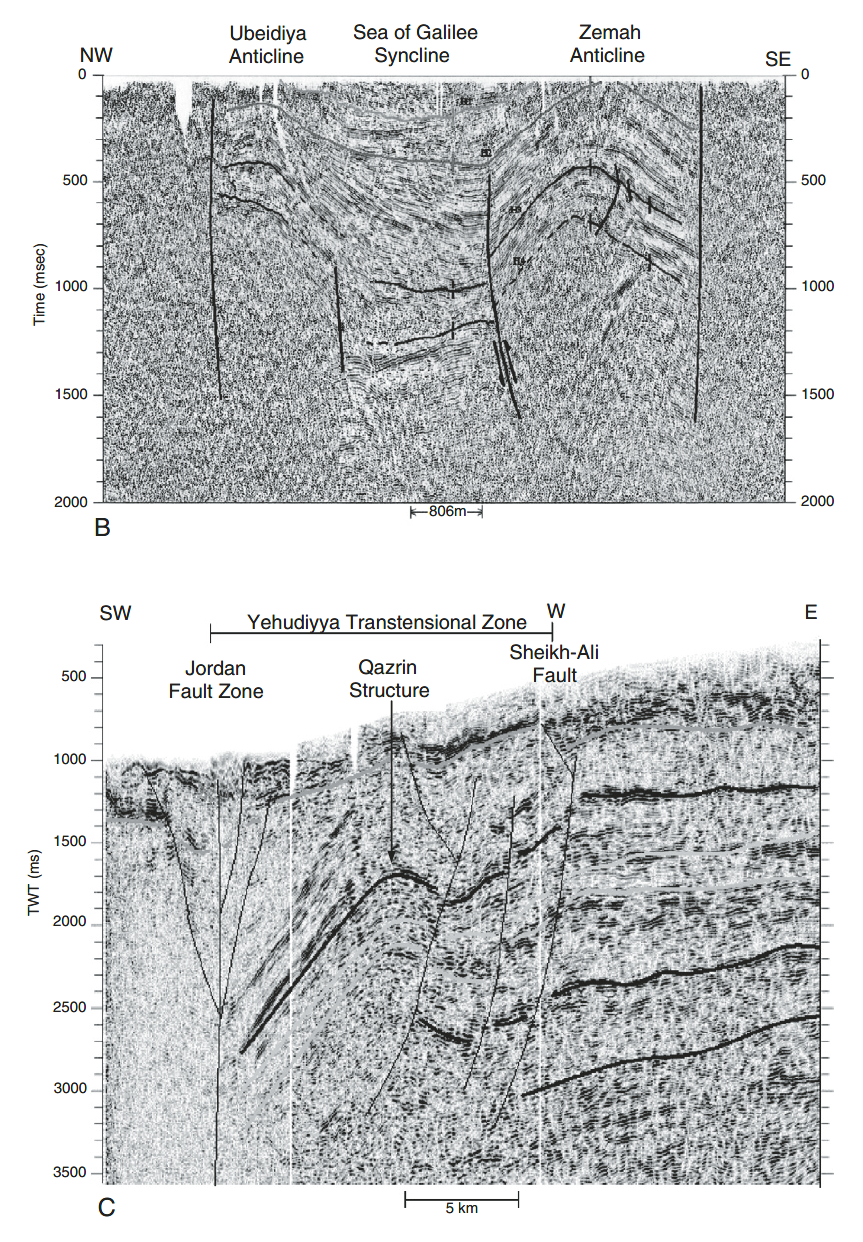
 Fig. 17.5 B and C
Fig. 17.5 B and CProfiles from the Sea of Galilee. B Profile from south of the lake showing both compressional and asymmetrical features (Zurieli, 2002). C Profile from north of the lake showing the Yehudiyya transtensional zone. Within the zone lies a compressional feature, the Qazrin structure, which is bordered on the west by the main fault zone (Shulman et al., 2004). Ben-Avraham et al (2012) |
Fig. 17.5 B and C - Sea of Galilee |
The Zemah anticline, a large compressional feature south of the Sea of Galilee in the Kinarot valley (Fig. 17.5B), is at least 4 km long, 2500 m wide and reaches depths of at least 4 km. Figure 17.5B (Zurieli, 2002) clearly hows that the eastern limb of this structure is thicker than the western one (by almost 50%).The anticline is bounded by two faults; the one to the east reach the surface as opposed to the one in the west, which exhibits reverse fault geometry. Other faults can be found at the base of the feature. The Zemah-1 well was drilled on top of the structure and penetrated 4300 m of graben fill consisting of clas-tics, evaporites, intrusive and igneous rocks, with only relatively thin layers of salt present. An additional compressional structure the Ubeidiya structure) is evi¬dent in Fig. 17.5B around 3.5 km west of the Zemah anticline. This element is much smaller (around 800 m wide) and oriented to the northwest. Both elements are thought to have been formed sometime between 0.8 and 1.4 Myr. Rotstein et al. (1992) have suggested that reverse faulting in the Zemah anticline indicates that it is a compressional feature unrelated to igneous activity or salt diapirsm. Between these two compressional structures, an asymmetrical basin, which is the continuation of the Sea of Galilee syncline, is present. Rotstein et al. (1992) have also suggested that the basin in the southern Sea of Galilee and the Kinarot Valley was formed by two overlapping strike-slip faults. Zurieli (2002) proposed that the compressional features can be explained by assuming that the basin is a hybrid pull-apart, that is bordered on both sides by faults with different rates of lateral motion. The Golan Heights lie to the east of the Sea of Galilee and their internal structure is governed by the adjacent northern Dead Sea fault and the Palmyride folding. The Golan Heights can be divided into two separate sections by the Yehudiyya block, or the Yehudiyya transtensional zone (Shulman et al., 2004). The zone is part of a distinct extensional region, or sub-basin, which is confined by:
- a branch of the Jordan Fault (Fig. 17.5C) in the west (the Meshoshim fault)
- the southwest-northeast trending Sheikh-Ali fault, in the east and northeast
- by the Sea of Galilee in the southwest. The Neogene activation of the Sheikh-Ali fault, which branches to the northeast off the north-south trending Dead Sea fault, was the most significant tectonic phase that shaped the structural framework of the Golan Heights.
| Source | Image | Description |
|---|---|---|
| Ben-Avraham et al (2012) |

 Fig. 17.6
Fig. 17.6
(after Zilberman et al., 2000). Ben-Avraham et al (2012) |
Fig. 17.6 - Hula Basin |
The eastern structural boundary of the Hula Valley forms a complex fault pattern, reflecting a westward migration of tectonic activity during the Pleistocene (Heimann, 1990). The youngest branch is the Azaz fault, separates the western margins of the basalt plateau of the Golan Heights from the sedimentary fill of the valley (Fig. 17.6).
The Azaz fault is a sinistral strike—slip fault consisting of several segments arranged in a right-stepping en-echelon pattern striking NNE (Heimann, 1990). Small push-up structures, expressed as small hills, occur between neighboring segments (Fig. 17.6). Both the Rachaya fault and the Azaz fault are considered to be currently active.
| Source | Image | Description |
|---|---|---|
| Ben-Avraham et al (2012) |

 Fig. 17.7
Fig. 17.7
Ben-Avraham et al (2012) |
Fig. 17.7 - Ghab Basin |
The structure and kinematics of the Dead Sea Transform are more complex and obscure to the north (Walley, 1998). While about 25 km of left lateral displacement in Lebanon and western Syria is generally accepted, there is some debate and claims of an offset of 80 km or more near the Syrian-Turkish border. A lateral offset of ca. 100 km across Lebanon has been suggested on the basis of structural correlations across the Dead Sea fault. Resolution of this question must await a comprehensive comparison of the structure and stratigraphy on both sides of this segment of the Dead Sea fault, similar to what was done along its southern segment (e.g., Freund et al., 1970). Cenozoic deformation is distributed across a range of faults and folds from the Levant coast across to the Palmyrides of Syria. The timing and significance of these structures is highly controversial. Within Lebanon, the Dead Sea Transform is represented by some or all of an array of fault strands. Most large-scale reviews of plate boundary continuity consider one of these structures, the Yammouneh Fault, to be the main strand. This fault maps along a NNE-SSW trend, implying a general restraining bend geometry to the transform.
The Ghab basin
The Ghab basin is located on the active, yet poorly understood, northern segment of the Dead Sea fault system. It formed during the Plio-Quaternary as a result of a complex step-over zone along the fault. Subsidence occurred along cross-basin and transform-parallel faults in two asymmetric depocenters. The larger depocenter in the south of the basin is asymmetric towards the east, the margin along which most active transform displacement apparently occurs. This suggests that, at the latitude of the Ghab Basin, most of the lateral movement on the Dead Sea fault is accommodated on the eastern bounding fault of the basin.In contrast, the second, smaller depocenter to the north is somewhat asymmetric toward the western bounding fault (Brew, 2001)(Fig. 17.7).
Motion along the Dead Sea fault is not pure strike-slip and the direction of the plate boundary changes several times
resulting in areas of transtension and transpression. This is evident by the variable morphology and structure,
which is characterized by extensional, compressional and asymmetrical features. These features vary in size, from the
large-scale, which define the general structure of the valley, to the small-scale, which define the internal structure.
The Dead Sea fault valley itself is a large-scale transtensional feature, which formed as a result of oblique strike-slip
motion along the fault. The extensional component of motion is largely responsible for the formation of pull-apart basins
that occupy its length. Compression is caused by a step to the right of the left lateral strike-slip master fault and
results in structural saddles, which separate the main basins along the valley. Smaller compressional uplifts divide
several of the major pull-aparts into sub-basins and also occur along the fault valley. However, it is often hard to
determine whether these intra-basinal features are salt-related. Asymmetry is evident in the structure and topography
of the highlands, which border the valley and in the basins that lie within. The large-scale asymmetry across the Dead
Sea fault can perhaps be explained by the combined effect of normal faulting and isostatic uplift on existing pre-rift
topography (Wdowinski and Zilberman, 1996).
Numerous examples of basin asymmetry and compression features have been presented from locations worldwide, indicating that
these are not local phenom¬ena limited to the Dead Sea fault valley. The Cariaco basin in Venezuela, which crosses the
El Pilar fault, shows many similarities to the Dead Sea basin, displaying a clear asymmetry towards the main fault
(Ben-Avraham and Zoback, 1992). Additional examples exist along other continental transform faults and rift valleys,
such as the Motagua fault system in Guatemala, Lake Baikal, Lake Tanganyika in the East African rift system and the
north Anatolian fault in Turkey. Transform-normal extension may help explain the small-scale asymmetries observed
within the basins themselves. This seemingly contradicts the basic assumption that pull-aparts are formed as a result
of overlapping strike-slip faults. However, it is the extensional component that arises from such fault arrangements
that may well be responsible for resolving this 'conflict' ('leaky transform', Garfunkel, 1981). It is interesting to
note that very little or no mantle uplift exists under the Dead Sea fault in the Arava valley. This may explain the
large negative gravity anomalies associated with the fault that reflect primarily the thick sedimentary sequences
including salt layers, which are abundant along the length of the valley.
| Source | Image | Description |
|---|---|---|
| Ben-Avraham et al (2012) |

 Fig. 17.1
Fig. 17.1Tectonic setting of the Dead Sea fault — a transform plate boundary that connects the opening of the Red Sea with the collision in Turkey. Boxes indicate basins along the fault valley discussed in the text.
Ben-Avraham et al (2012) |
Fig. 17.1 - DST Tectonics |
| Ben-Avraham et al (2012) |


Profiles and location map from the Gulf of Elat.
Ben-Avraham et al (2012) |
Fig. 17.2 - Gulf of Elat |
| Ben-Avraham et al (2012) |


Profiles from the Zofar basin in the Arava valley.
Ben-Avraham et al (2012) |
Fig. 17.3 - Arava |
| Ben-Avraham et al (2012) |


Profiles from the Dead Sea basin.
Ben-Avraham et al (2012) |
Fig. 17.4 - Dead Sea Basin |
| Ben-Avraham et al (2012) |

 Fig. 17.5
Fig. 17.5Profiles from the Sea of Galilee. A Location map showing main tectonic elements in the Sea of Galilee area. Bold lines indicated major faults, while dotted lines show the position of seismic profiles. Grey area shows the extent of the Yehudiyya transtensional one (after Shulman et al., 2004). Ben-Avraham et al (2012) |
Fig. 17.5A - Sea of Galilee |
| Ben-Avraham et al (2012) |

 Fig. 17.5 B and C
Fig. 17.5 B and CProfiles from the Sea of Galilee. B Profile from south of the lake showing both compressional and asymmetrical features (Zurieli, 2002). C Profile from north of the lake showing the Yehudiyya transtensional zone. Within the zone lies a compressional feature, the Qazrin structure, which is bordered on the west by the main fault zone (Shulman et al., 2004). Ben-Avraham et al (2012) |
Fig. 17.5 B and C - Sea of Galilee |
| Ben-Avraham et al (2012) |

 Fig. 17.6
Fig. 17.6
(after Zilberman et al., 2000). Ben-Avraham et al (2012) |
Fig. 17.6 - Hula Basin |
| Ben-Avraham et al (2012) |

 Fig. 17.7
Fig. 17.7
Ben-Avraham et al (2012) |
Fig. 17.7 - Ghab Basin |




